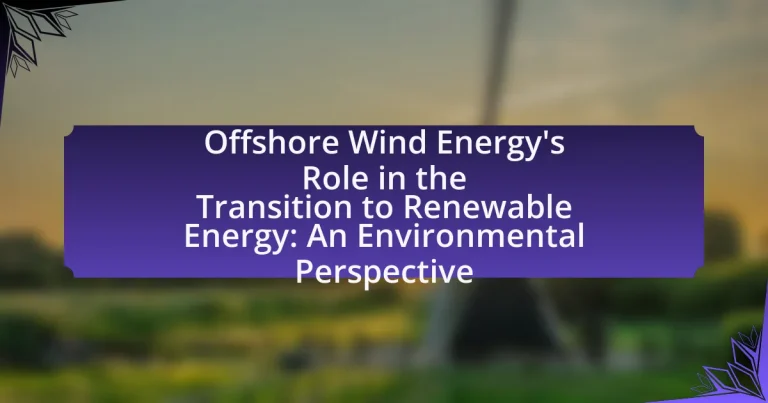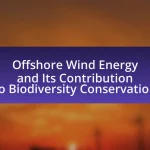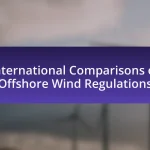Offshore wind energy is the generation of electricity from wind turbines situated in bodies of water, playing a critical role in the transition to renewable energy by reducing reliance on fossil fuels and minimizing greenhouse gas emissions. The article explores the significance of offshore wind energy in achieving global energy needs, its environmental benefits compared to fossil fuels, and its impact on local ecosystems and communities. It also addresses the technologies involved, challenges faced, regulatory hurdles, and the importance of public perception and community engagement in successful project implementation. Furthermore, the article highlights future trends, innovations, and best practices for sustainable offshore wind energy development.
What is Offshore Wind Energy and its Importance in Renewable Energy Transition?
Offshore wind energy refers to the generation of electricity from wind turbines located in bodies of water, typically on the continental shelf. This form of energy is crucial in the renewable energy transition as it harnesses strong and consistent wind resources, which can significantly reduce reliance on fossil fuels. According to the International Energy Agency, offshore wind capacity is projected to reach 234 gigawatts by 2030, highlighting its potential to contribute to global energy needs while minimizing greenhouse gas emissions. The deployment of offshore wind farms not only supports energy diversification but also creates jobs and stimulates economic growth in coastal regions, making it a vital component of sustainable energy strategies.
How does Offshore Wind Energy contribute to reducing carbon emissions?
Offshore wind energy significantly contributes to reducing carbon emissions by generating electricity without burning fossil fuels. This renewable energy source harnesses wind power to produce clean energy, which directly replaces electricity generated from carbon-intensive sources like coal and natural gas. According to the Global Wind Energy Council, in 2020, offshore wind energy helped avoid approximately 200 million tons of CO2 emissions globally. By expanding offshore wind capacity, countries can further decrease their reliance on fossil fuels, thereby accelerating the transition to a low-carbon economy.
What are the environmental benefits of Offshore Wind Energy compared to fossil fuels?
Offshore wind energy significantly reduces greenhouse gas emissions compared to fossil fuels. Specifically, offshore wind farms produce electricity without emitting carbon dioxide or other harmful pollutants during operation, unlike fossil fuel power plants, which are major contributors to air pollution and climate change. For instance, a study by the National Renewable Energy Laboratory found that wind energy can reduce carbon emissions by up to 80% compared to coal and natural gas. Additionally, offshore wind energy has a smaller ecological footprint, as it requires less land use and can coexist with marine ecosystems, promoting biodiversity. In contrast, fossil fuel extraction and combustion lead to habitat destruction and significant environmental degradation.
How does Offshore Wind Energy impact local ecosystems?
Offshore wind energy impacts local ecosystems primarily through habitat alteration and potential disruption to marine life. The installation of wind turbines can change the physical environment, affecting sediment dynamics and local species distributions. Research indicates that the presence of wind farms can lead to increased biodiversity in some areas, as structures may provide artificial reefs that attract various marine organisms. However, the construction and operation phases can also pose risks, such as noise pollution and collision hazards for birds and marine mammals. Studies, including those by the National Renewable Energy Laboratory, highlight the need for careful site selection and monitoring to mitigate negative effects while maximizing ecological benefits.
What are the key technologies involved in Offshore Wind Energy?
The key technologies involved in offshore wind energy include wind turbine technology, floating platforms, and subsea cabling systems. Wind turbine technology is essential as it converts wind energy into electricity, with advancements in turbine design increasing efficiency and capacity. Floating platforms enable the installation of turbines in deeper waters where traditional fixed-bottom foundations are not feasible, expanding the potential for offshore wind farms. Subsea cabling systems are crucial for transmitting the generated electricity from offshore turbines to onshore grids, ensuring effective energy distribution. These technologies collectively enhance the viability and scalability of offshore wind energy projects, contributing significantly to the transition to renewable energy sources.
What types of turbines are used in Offshore Wind Energy projects?
Offshore wind energy projects primarily utilize two types of turbines: fixed-bottom turbines and floating turbines. Fixed-bottom turbines are anchored to the seabed and are typically used in shallow waters, while floating turbines are designed to be moored to the seabed using cables and can operate in deeper waters. According to the Global Wind Energy Council, as of 2022, fixed-bottom turbines account for approximately 90% of installed offshore capacity, while floating turbines are gaining traction due to advancements in technology and increasing interest in deeper offshore sites.
How do floating wind farms differ from traditional offshore wind farms?
Floating wind farms differ from traditional offshore wind farms primarily in their foundation design; floating wind farms are anchored to the seabed using mooring lines and can operate in deeper waters, while traditional offshore wind farms are fixed to the seabed and are limited to shallower areas. This capability allows floating wind farms to access stronger and more consistent wind resources, which can enhance energy production efficiency. For instance, floating wind technology enables installations in locations like the North Sea, where water depths exceed 60 meters, making it feasible to harness wind energy in areas previously inaccessible to fixed-bottom turbines.
What challenges does Offshore Wind Energy face in the transition to renewable energy?
Offshore wind energy faces several challenges in the transition to renewable energy, including high initial capital costs, regulatory hurdles, and environmental concerns. The installation of offshore wind farms requires significant investment in infrastructure, with costs averaging around $3,000 to $6,000 per installed kilowatt, which can deter investment. Additionally, navigating complex regulatory frameworks and obtaining necessary permits can delay project timelines and increase costs. Environmental concerns, such as the impact on marine ecosystems and bird migration patterns, also pose challenges, as projects must undergo extensive environmental assessments to mitigate potential harm. These factors collectively hinder the rapid expansion of offshore wind energy as a viable renewable energy source.
What are the regulatory hurdles for Offshore Wind Energy development?
The regulatory hurdles for offshore wind energy development include complex permitting processes, environmental impact assessments, and compliance with federal and state regulations. These hurdles arise from the need to balance energy production with environmental protection, as projects must undergo rigorous evaluations to assess their effects on marine ecosystems, navigation, and local communities. For instance, the Bureau of Ocean Energy Management (BOEM) requires extensive documentation and stakeholder engagement before granting leases, which can prolong project timelines and increase costs. Additionally, interconnection agreements with utility companies and adherence to the National Environmental Policy Act (NEPA) further complicate the regulatory landscape, making it essential for developers to navigate a multifaceted approval process.
How does public perception affect Offshore Wind Energy projects?
Public perception significantly influences Offshore Wind Energy projects by shaping community support, regulatory approval, and investment decisions. Positive public perception can lead to increased acceptance and faster project implementation, as seen in regions where communities actively engage in discussions about the benefits of renewable energy. Conversely, negative perceptions, often driven by concerns over environmental impacts, visual aesthetics, or noise, can result in opposition, delays, and increased costs. For instance, a study by the National Renewable Energy Laboratory found that projects with strong community engagement and positive public sentiment experienced a 30% higher likelihood of successful completion compared to those facing public resistance.
How does Offshore Wind Energy interact with marine environments?
Offshore wind energy interacts with marine environments primarily through the installation of wind turbines, which can alter local ecosystems. The presence of turbines can create artificial reefs, promoting marine biodiversity, but they may also disrupt habitats and migratory patterns of marine species. Studies indicate that the construction and operation of offshore wind farms can lead to changes in sediment dynamics and water quality, impacting marine life. For instance, research published in the journal “Marine Policy” highlights that while offshore wind farms can enhance fish populations by providing new habitats, they can also pose risks to seabirds and marine mammals due to potential collisions and noise pollution.
What are the potential impacts of Offshore Wind Energy on marine wildlife?
Offshore wind energy can significantly impact marine wildlife through habitat alteration, noise pollution, and potential collisions with turbine structures. The construction and operation of wind farms can lead to changes in local ecosystems, affecting species such as fish, marine mammals, and seabirds. For instance, studies have shown that the installation of wind turbines can disrupt the natural behavior of marine mammals due to increased underwater noise levels, which can interfere with their communication and navigation. Additionally, the presence of turbines may pose collision risks for birds and bats, particularly during migration periods. Research conducted by the National Renewable Energy Laboratory indicates that while some species may adapt to these changes, others could face population declines due to habitat loss and increased mortality rates.
How can Offshore Wind Energy projects be designed to minimize ecological disruption?
Offshore Wind Energy projects can be designed to minimize ecological disruption by implementing careful site selection, utilizing advanced technology, and conducting thorough environmental assessments. Site selection involves avoiding ecologically sensitive areas, such as migratory bird pathways and marine habitats, which can significantly reduce potential impacts on wildlife. Advanced technology, such as floating wind turbines, allows for installation in deeper waters, further distancing projects from critical habitats. Additionally, conducting comprehensive environmental assessments before project initiation helps identify potential ecological risks and informs mitigation strategies, ensuring that the projects align with conservation goals. These practices are supported by studies indicating that strategic planning and technology can effectively reduce the ecological footprint of offshore wind installations.
What measures are in place to monitor and mitigate environmental impacts?
Measures to monitor and mitigate environmental impacts in offshore wind energy projects include environmental impact assessments (EIAs), continuous environmental monitoring, and adaptive management strategies. EIAs are conducted prior to project approval to evaluate potential ecological effects, ensuring compliance with regulations. Continuous monitoring involves tracking marine life, water quality, and habitat changes during and after construction, which helps identify any adverse effects promptly. Adaptive management strategies allow for modifications in operations based on monitoring results, ensuring that environmental impacts are minimized over time. These measures are supported by regulatory frameworks and guidelines established by organizations such as the International Energy Agency and the European Commission, which emphasize the importance of sustainable practices in renewable energy development.
How does Offshore Wind Energy influence coastal communities?
Offshore wind energy positively influences coastal communities by providing economic benefits, job creation, and promoting sustainable development. The establishment of offshore wind farms generates local employment opportunities in construction, maintenance, and operation, which can significantly boost the local economy. For instance, a report by the U.S. Department of Energy indicates that the offshore wind sector could create over 77,000 jobs by 2030. Additionally, offshore wind projects can enhance local infrastructure and attract investments, further contributing to community resilience and sustainability.
What economic benefits can Offshore Wind Energy bring to local economies?
Offshore wind energy can significantly boost local economies by creating jobs, increasing tax revenues, and stimulating local businesses. The construction and maintenance of offshore wind farms generate thousands of jobs in various sectors, including manufacturing, installation, and operations. For instance, a report by the U.S. Department of Energy indicates that the offshore wind sector could create over 77,000 jobs by 2030. Additionally, local governments benefit from increased tax revenues from wind farm operations, which can be reinvested into community services and infrastructure. Furthermore, local businesses, such as suppliers and service providers, experience growth due to the demand generated by offshore wind projects, enhancing overall economic activity in the region.
How does Offshore Wind Energy affect tourism and recreational activities?
Offshore wind energy can positively and negatively affect tourism and recreational activities. On one hand, the presence of offshore wind farms can enhance tourism by attracting visitors interested in renewable energy and sustainability, as seen in regions like Denmark, where wind energy tourism has become a niche market. On the other hand, concerns about visual impacts, noise, and potential disruptions to marine ecosystems can deter some tourists and recreational activities, particularly in areas known for natural beauty or wildlife. Studies indicate that while some tourists may be put off by wind farms, others appreciate their role in combating climate change, suggesting a complex relationship between offshore wind energy and tourism.
What is the future outlook for Offshore Wind Energy in the renewable energy landscape?
The future outlook for offshore wind energy in the renewable energy landscape is highly promising, with significant growth projected in capacity and investment. According to the International Energy Agency (IEA), offshore wind capacity is expected to increase from 35 gigawatts (GW) in 2020 to over 200 GW by 2030, driven by technological advancements and supportive government policies. This expansion is supported by the global push for decarbonization and the need to meet climate targets, as offshore wind energy offers a reliable and sustainable source of electricity. Additionally, the Global Wind Energy Council (GWEC) reported that investments in offshore wind are anticipated to reach $1 trillion by 2040, indicating strong market confidence and commitment to this sector.
How is Offshore Wind Energy expected to evolve in the coming years?
Offshore wind energy is expected to experience significant growth in the coming years, driven by advancements in technology, increased investment, and supportive government policies. The Global Wind Energy Council projects that global offshore wind capacity could reach 234 GW by 2030, up from approximately 35 GW in 2020, indicating a rapid expansion in this sector. Additionally, innovations such as larger turbine sizes and floating wind farms are enhancing efficiency and enabling deployment in deeper waters, further contributing to the sector’s evolution.
What innovations are on the horizon for Offshore Wind Energy technology?
Innovations on the horizon for Offshore Wind Energy technology include advancements in floating wind turbine designs, which allow for deployment in deeper waters, and improvements in turbine efficiency through larger rotor diameters and enhanced materials. Floating wind farms can be installed in locations previously deemed unsuitable, potentially increasing global offshore wind capacity significantly. For instance, the use of lighter and stronger materials, such as carbon fiber, is expected to reduce costs and improve performance. Additionally, digital technologies like AI and machine learning are being integrated for predictive maintenance and optimization of energy output, enhancing operational efficiency. These innovations are supported by ongoing research and development initiatives, such as those conducted by the National Renewable Energy Laboratory, which highlight the potential for offshore wind to contribute substantially to renewable energy goals.
How will policy changes impact the growth of Offshore Wind Energy?
Policy changes will significantly enhance the growth of offshore wind energy by providing financial incentives, streamlining permitting processes, and establishing clear regulatory frameworks. For instance, countries like the United States and the United Kingdom have implemented policies that include tax credits and subsidies, which have led to increased investments in offshore wind projects. According to the International Energy Agency, global offshore wind capacity is expected to reach 234 GW by 2030, driven largely by supportive government policies. These changes not only attract private investment but also facilitate technological advancements and infrastructure development, further accelerating the deployment of offshore wind energy solutions.
What best practices should be followed for sustainable Offshore Wind Energy development?
Sustainable offshore wind energy development should prioritize environmental impact assessments, stakeholder engagement, and the use of advanced technology. Conducting thorough environmental impact assessments ensures that potential effects on marine ecosystems and local communities are identified and mitigated. Engaging stakeholders, including local communities, fishermen, and environmental groups, fosters transparency and collaboration, which can lead to more socially acceptable projects. Utilizing advanced technology, such as floating wind turbines and predictive modeling, enhances efficiency and reduces costs while minimizing ecological disruption. These practices are supported by studies indicating that comprehensive assessments and community involvement significantly improve project outcomes and sustainability.
How can stakeholders collaborate to enhance the environmental benefits of Offshore Wind Energy?
Stakeholders can collaborate to enhance the environmental benefits of Offshore Wind Energy by engaging in joint research initiatives, sharing best practices, and establishing regulatory frameworks that prioritize ecological sustainability. Collaborative research can lead to innovative technologies that minimize environmental impacts, such as advanced turbine designs that reduce noise and wildlife disruption. Sharing best practices among developers, environmental organizations, and government agencies can facilitate the implementation of effective mitigation strategies, ensuring that offshore wind projects are designed with ecological considerations in mind. Furthermore, establishing regulatory frameworks that incorporate stakeholder input can create guidelines that promote biodiversity protection and habitat restoration, ultimately maximizing the positive environmental impacts of offshore wind energy projects.
What role does community engagement play in successful Offshore Wind Energy projects?
Community engagement is crucial for the success of Offshore Wind Energy projects as it fosters local support, mitigates opposition, and enhances project sustainability. Engaging communities allows developers to address concerns, incorporate local knowledge, and build trust, which can lead to smoother project implementation. Studies have shown that projects with strong community involvement experience fewer delays and reduced costs, as seen in the Block Island Wind Farm, where local engagement led to a successful launch and ongoing support from residents.




